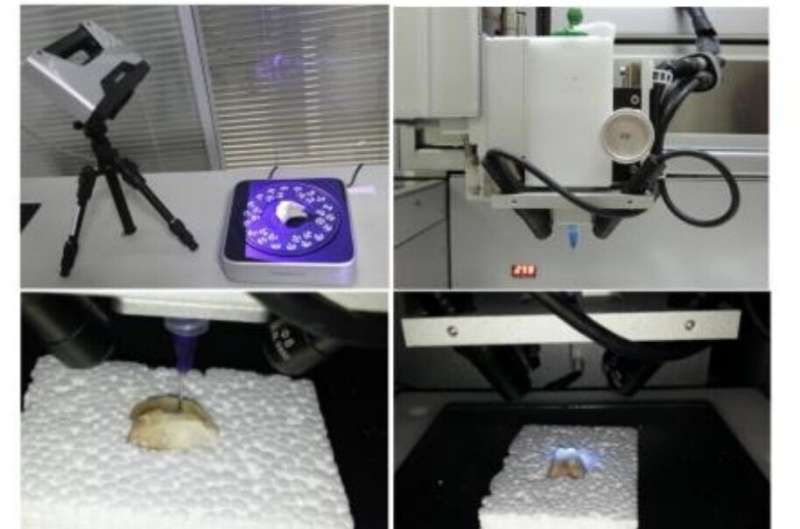June 22, 2023 feature
This article has been reviewed according to Science X's editorial process and policies. Editors have highlighted the following attributes while ensuring the content's credibility:
fact-checked
trusted source
proofread
Review of recent progress in robotic printing of surgical implants promoting cartilage regeneration

Over the course of their lives, some humans can partly or fully lose the ability to move their limbs because of damage to their cartilage, the flexible connective tissues cushioning the bones. This can be due to degenerative diseases, such as osteoarthritis, or physical injuries.
Damage to the cartilage can cause significant pain and disability, adversely impacting the quality of life of affected individuals. Existing surgical procedures designed to repair this damage or reduce its impact typically achieve limited results, with patients reporting very few benefits and no or little long-term effects.
Medical researchers and engineers have thus been trying to devise alternative therapeutic interventions aimed at repairing cartilage damage more effectively. In recent years, 3D bio-printing, which relies on advanced printers to create three-dimensional biochemical and biophysical systems, emerged as a promising solution to create systems that can promote tissue regeneration.
Researchers at University of Manchester, Nanyang Technological University, and other universities worldwide recently reviewed recent works aimed at using bioprinting to engineer the repair of cartilage tissue. Their review paper, published in the International Journal of Extreme Manufacturing, highlights both the potential advantages and limitations of this emerging solution.
"3D bioprinting has been used to fabricate biochemical and biophysical environments that aim to recapitulate the native microenvironment and promote tissue regeneration," Yaxin Wang, Ruben Pereira and their colleagues wrote in their paper. "However, conventional in vitro bioprinting has limitations, due to the challenges associated with the fabrication and implantation of printed constructs and integration with the native cartilage tissue."
Initially, researchers tried to use 3D bioprinting technology to create systems that could later be implanted inside the human bodies, replicating the function of biological systems and promoting the regeneration of damaged cartilage. These approaches, known as in-vitro approaches, can have significant limitations, as the created systems can be difficult to implant or might not be received well by the patients' body, poorly integrating with their biological cartilage.
Some teams have recently been exploring the potential of an alternative approach, known as in situ bioprinting, which could potentially circumvent these issues. In their review paper, Wang, Perreira and their colleagues summarized existing works assessing this approach, particularly its implementations using robotic tools.
"In situ bioprinting is a novel strategy to directly deliver bioinks to the desired anatomical site and has the potential to overcome major shortcomings associated with conventional bioprinting," the researchers wrote. "In this review, we focus on the new frontier of robotic-assisted in situ bioprinting surgical systems for cartilage regeneration."
Wang, Perreira and their colleagues examine different proposed robot-assisted in situ bioprinting approaches, some of which are minimally invasive and others non-invasive. As open surgeries can have significant complications, these approaches would be particularly desirable, even if they are still at very early stages of development.
When reviewing previous efforts in this area, they found that the use of rigid or semi-rigid printing nozzles could greatly increase the complexity of these procedures, thus flexible robotic systems with high degrees of freedom could be a valuable alternative. Some researchers also tried to devise approaches that rely on digital near-infrared technology to print ear-like structures directly on a patient's body, although this approach is far harder, if not impossible, to implement inside the body.
Other proposed in situ approaches to promote the regeneration of cartilage rely on the use of tiny robots that can enter the body without damaging it, performing desirable procedures. These robots could, for instance, deliver stem cells or substances at injured sites inside the body, yet they could also potentially be integrated with 3D bioprinting tools, to directly print biological systems in targeted regions.
While all these approaches could be promising, several challenges will need to be overcome and many trials will need to be carried out before they can be tested on humans and introduced in clinical settings. The recent paper by Wang, Perreira and his colleagues offers a broad overview of the stage at which these promising strategies are today, while also highlighting areas ways in which they could be developed further in the future.
More information: Yaxin Wang et al, Robotic in situ bioprinting for cartilage tissue engineering, International Journal of Extreme Manufacturing (2023). DOI: 10.1088/2631-7990/acda67
© 2023 Science X Network




















